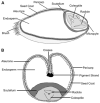Implications of Blending Pulse and Wheat Flours on Rheology and Quality Characteristics of Baked Goods: A Review
- PMID: 37431033
- PMCID: PMC9601813
- DOI: 10.3390/foods11203287
Implications of Blending Pulse and Wheat Flours on Rheology and Quality Characteristics of Baked Goods: A Review
Abstract
Bread is one of the most widely consumed foods in all regions of the world. Wheat flour being its principal ingredient is a cereal crop low in protein. The protein content of a whole grain of wheat is about 12-15% and is deficit in some essential amino acids, for example, lysine. Conversely, the protein and fibre contents of legume crops are between 20 and 35% and 15 and 35%, respectively, depending on the type and cultivar of the legume. The importance of protein-rich diets for the growth and development of body organs and tissues as well as the overall functionality of the body is significant. Thus, in the last two decades, there has been a greater interest in the studies on the utilization of legumes in bread production and how the incorporation impacts the quality characteristics of the bread and the breadmaking process. The addition of plant-based protein flours has been shown to produce an improved quality characteristic, especially the nutritional quality aspect of bread. The objective of this review is to synthesize and critically investigate the body of research on the impact of adding legume flours on the rheological attributes of dough and the quality and baking characteristics of bread.
Keywords: baking characteristics; composite flour; food quality; protein substitution; quality characteristics.
Conflict of interest statement
The authors declare no conflict of interest.
Figures
Similar articles
-
Effects of Adding Legume Flours on the Rheological and Breadmaking Properties of Dough.Foods. 2021 May 14;10(5):1087. doi: 10.3390/foods10051087. Foods. 2021. PMID: 34068906 Free PMC article.
-
White Lupine (Lupinus albus L.) Flours for Healthy Wheat Breads: Rheological Properties of Dough and the Bread Quality.Foods. 2023 Apr 14;12(8):1645. doi: 10.3390/foods12081645. Foods. 2023. PMID: 37107440 Free PMC article.
-
Processing strategies to improve the breadmaking potential of whole-grain wheat and non-wheat flours.Discov Food. 2022;2(1):11. doi: 10.1007/s44187-022-00012-w. Epub 2022 Mar 2. Discov Food. 2022. PMID: 40477606 Free PMC article. Review.
-
Effect of brown rice flour fortification on the quality of wheat-based dough and flat bread.J Food Sci Technol. 2014 Oct;51(10):2821-6. doi: 10.1007/s13197-012-0716-x. Epub 2012 Jun 16. J Food Sci Technol. 2014. PMID: 25328232 Free PMC article.
-
Feasibility of commercial breadmaking using chickpea as an ingredient: Functional properties and potential health benefits.J Food Sci. 2021 Jun;86(6):2208-2224. doi: 10.1111/1750-3841.15759. Epub 2021 May 24. J Food Sci. 2021. PMID: 34028013 Review.
Cited by
-
Enhancing Gluten-Free Crispy Waffles with Soybean Residue (Okara) Flour: Rheological, Nutritional, and Sensory Impacts.Foods. 2024 Sep 18;13(18):2951. doi: 10.3390/foods13182951. Foods. 2024. PMID: 39335884 Free PMC article.
-
Impact of Particle Size on the Physicochemical, Functional, and In Vitro Digestibility Properties of Fava Bean Flour and Bread.Foods. 2024 Sep 10;13(18):2862. doi: 10.3390/foods13182862. Foods. 2024. PMID: 39335791 Free PMC article.
-
Evaluation of the Functional Properties and Edible Safety of Concocted Xanthii Fructus Protein.Foods. 2025 May 28;14(11):1913. doi: 10.3390/foods14111913. Foods. 2025. PMID: 40509441 Free PMC article.
-
Impact of Ferulated Arabinoxylans from Maize Bran on Farinograph and Pasting Properties of Wheat Flour Blends.Foods. 2024 Oct 26;13(21):3414. doi: 10.3390/foods13213414. Foods. 2024. PMID: 39517198 Free PMC article.
-
Glycemic impact of cereal and legume-based bakery products: Implications for chronic disease management.Food Chem X. 2024 Nov 1;24:101959. doi: 10.1016/j.fochx.2024.101959. eCollection 2024 Dec 30. Food Chem X. 2024. PMID: 39568514 Free PMC article. Review.
References
-
- William R. Bread: A Global History. 1st ed. Reaktion Books Ltd.; London, UK: 2011. pp. 10–21.
-
- Mondal A., Datta A.K. Bread Baking—A Review. J. Food Eng. 2008;86:465–474. doi: 10.1016/j.jfoodeng.2007.11.014. - DOI
-
- Scanlon M.G., Zghal M.C. Bread properties and crumb structure. Food Res. Int. 2001;34:841–864. doi: 10.1016/S0963-9969(01)00109-0. - DOI
-
- Campbell G.M., Fang C., Muhamad I.I. On predicting roller milling performance VI: Effect of kernel hardness and shape on the particle size distribution from first break milling of wheat. Food Bioprod. Process. 2007;85:7–23. doi: 10.1205/fbp06005. - DOI
Publication types
Grants and funding
LinkOut - more resources
Full Text Sources



